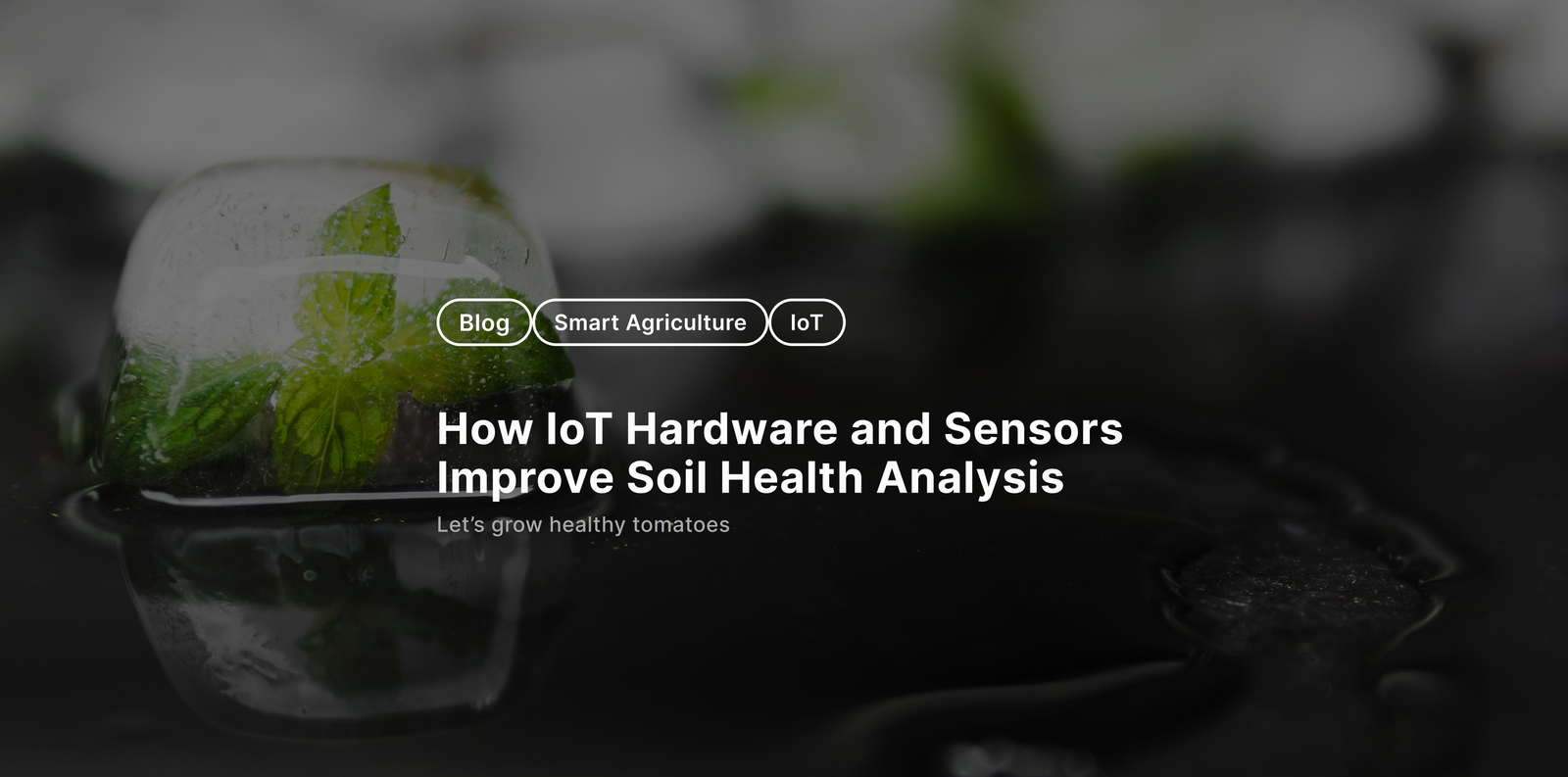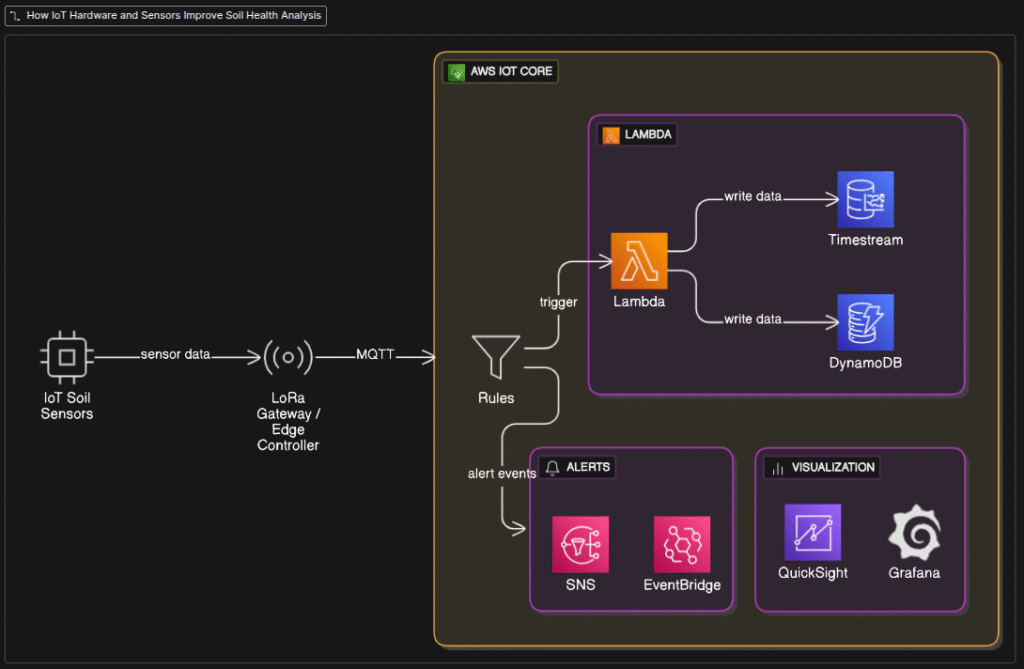✆ + 1-646-235-9076 ⏱ Mon - Fri: 24h/day
How IoT Hardware and Sensors Improve Soil Health Analysis


Soil Monitoring in 2025: The Intelligent Underground
In the past, understanding soil health required manual sampling and lab analysis. Farmers would dig, bag, and send soil to laboratories, waiting days or weeks for results, with limited repeatability or zone specificity.
By 2025, soil monitoring will have become continuous, real-time, and zone-aware, thanks to IoT-enabled sensors and connected hardware. What used to be a snapshot in time has become a video feed of the soil’s ongoing health status.
Key Advancements Over the Decades:
- Transition from occasional testing > to real-time, 24/7 monitoring
- From field-wide guesses > to zonal micro-management
- From manual logging > to cloud-based analytics
Sensors embedded in the ground now automatically track:
- Moisture and drainage patterns
- pH levels that affect nutrient absorption
- Electrical conductivity (EC) to monitor salinity and fertility
- Temperature, which impacts microbial activity and root growth
- NPK levels (Nitrogen, Phosphorus, Potassium) the fundamental plant nutrients
These real-time readings are automatically logged, analyzed, and visualized, transforming farms into living laboratories of soil intelligence.
Why Soil Health Analysis Is Crucial in 2025
Global Importance
Soil degradation threatens 95% of Earth’s farmland (UN FAO). Intensive agriculture, over-fertilization, erosion, and climate change have led to the loss of organic matter, imbalanced pH, and water inefficiency.
Farmer Benefits
With real-time soil health data, farmers can:
- Avoid overwatering and reduce water bills
- Optimize fertilizer timing and dosage
- Tailor treatment per zone, instead of treating the entire field equally
- Increase yields, reduce input costs, and improve sustainability
Key Metrics & What They Tell Us
| Metric | Description | Why It Matters |
|---|---|---|
| Soil Moisture | Measures water content in soil | Prevents under/over-watering; optimizes irrigation timing |
| pH | Acidity/alkalinity level (scale 1–14) | The ideal range (6.0–7.5) allows nutrient absorption; an imbalance reduces crop health |
| Electrical Conductivity (EC) | Measures salt content & ion activity | Indicates salinity, fertilizer residue, and soil fertility |
| Nitrogen (N) | Essential for leaf growth | Deficiency causes yellowing; excess leads to waste and pollution |
| Phosphorus (P) | Aids root development and flowering | Low P stunts growth; too much is wasted without proper pH |
| Potassium (K) | Regulates water uptake, enzyme activity | Helps build drought tolerance and plant immunity |
| Soil Temperature | Affects seed germination and microbial activity | Crucial for planting schedules and nutrient cycling |
| Organic Matter (OM) | Carbon content from decaying organisms | Improves structure, water retention, and soil life |
| Compaction (optional) | Resistance to penetration | Impacts root depth and aeration; high compaction reduces yield |
An imbalance in any one of these metrics can result in wasted fertilizer, poor growth, or reduced profit.
Real-World Successes in Smart Soil Monitoring
Ceres Imaging (California)
Combining aerial imaging + ground sensors for soil moisture and EC readings
Helped growers reduce water use by 30% while improving yields
Farm21 (Europe)
Wireless sensor network providing moisture, temperature, and salinity data every 15 minutes
Enabled precision fertilization, resulting in yield increases of 25–40%
CropX (USA/Israel)
ML + sensor-driven system for automatic NPK estimation
Reduced fertilizer overuse, protected groundwater, improved ROI
These examples show how real-time soil data leads to smarter decisions, higher land valuation, and market-ready produce.
Modern Soil Analysis Standards
With the rise of digital agriculture, standardization ensures trust and comparability across tools, regions, and growers.
Relevant Standards:
| Standard | Scope |
| ISO 23992:2022 | Framework for continuous soil monitoring |
| ISO 11783 (ISOBUS) | Standardized data exchange between devices and ag equipment |
| NRCS Soil Survey Manual (USDA) | Defines reference ranges for key metrics |
| SmartAg IoT Frameworks | Emerging sets of rules for connectivity and data interoperability |
| OECD Guidelines | Environmental protection compliance for sensor-enabled farms |
| FAO Voluntary Guidelines | Promote sustainable soil management practices globally |
Adherence to these standards helps ensure soil monitoring data is auditable, regulatory-compliant, and interoperable across devices and platforms.
Soil Monitoring Automation: How It Works
Core Automation Principles
- Zonal Monitoring: Divide the field into sections to track variation.
- Layered Sensing: Deploy sensors at 3–5 depths (10cm, 30cm, 50cm) for vertical analysis.
- Time-Based Sampling: Automated hourly/daily updates instead of manual logging.
- Threshold Alerts: Notifications when values go out of the ideal range.
- Integrated Action: Trigger irrigation, dosing, or planting when optimal.
Key Equipment Needed
| Component | Role |
| Moisture Probes | Track water levels to schedule irrigation |
| pH/EC Sensors | Measure acidity and salinity for nutrient planning |
| NPK Sensors | Monitor nitrogen, phosphorus, and potassium content |
| Soil Temp Sensors | Help predict root zone activity and seeding windows |
| LoRaWAN Gateways | Collect and transmit sensor data |
| Edge Devices | Buffer and process data locally |
| Actuators | Control irrigation valves, pumps, or alert systems |
Advanced platforms may also use drone-captured NDVI maps to correlate sensor data with vegetation health.
IoT Infrastructure: Soil-to-Cloud Intelligence
Wired vs. Wireless
| Type | Usage | Benefits | Trade-Offs |
| Wired (Modbus/Ethernet) | Centralized stations | Reliable, fast | Costly, less scalable |
| Wireless (LoRaWAN, Wi‑Fi) | Field-wide, multi-point | Flexible, long-range, solar-powered | Sensitive to range or interference |
Protocols
- MQTT – For efficient, lightweight communication
- HTTPS REST – API-based interaction with dashboards
- WebSockets – Live streaming metrics and real-time alerts
AWS-Based Cloud Workflow


- AWS Secrets Manager manages credentials and encryption keys
- CloudTrail + Config ensures compliance logging
- Kinesis or SageMaker (optional) adds predictive soil degradation modeling
Fordewind.io: Enabling Smart Soil Intelligence
At Fordewind.io, we’ve implemented soil-focused IoT architectures in multiple agricultural regions, transforming fields into data-rich, self-aware environments.
Our work includes:
- Help in designing multi-layered NPK/moisture pH systems using LoRaWAN and ESP32 MCUs
- Creating modular MQTT-based data pipelines that feed into AWS analytics and dashboards
- Supporting farmers with remote firmware updates, mobile UI dashboards, and real-time alerts
- Optimizing water and fertilizer usage
- Ensuring compliance with ISO, USDA, and SmartAg standards
We deliver custom-tailored solutions based on geography, soil type, crop cycle, and client infrastructure.
Conclusion
Healthy soil isn’t just a medium — it’s a living system, and today we finally have the tools to understand and protect it. In 2025, smart soil monitoring is a must-have for any serious farmer, agribusiness, or environmental program.
IoT hardware, connected sensors, and cloud platforms transform reactive decisions into data-driven, sustainable strategies. From tracking nutrient levels to scheduling precise irrigation, real-time soil analysis improves yields, profits, and the planet.
At Fordewind.io, we help turn your soil into a strategic asset — monitored, optimized, and connected.
Let’s bring intelligence underground — and grow a smarter, more resilient world.